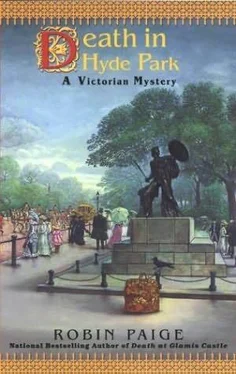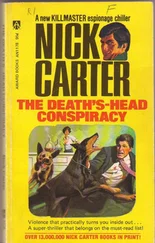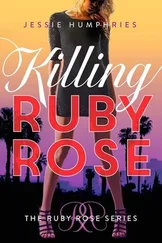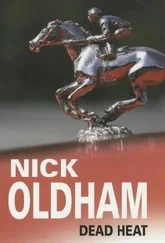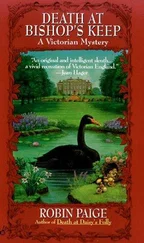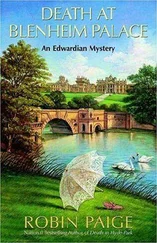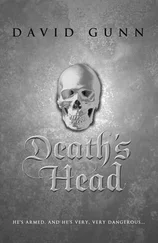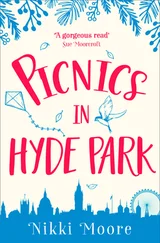Robin Paige - Death in Hyde Park
Здесь есть возможность читать онлайн «Robin Paige - Death in Hyde Park» весь текст электронной книги совершенно бесплатно (целиком полную версию без сокращений). В некоторых случаях можно слушать аудио, скачать через торрент в формате fb2 и присутствует краткое содержание. Жанр: Классический детектив, на английском языке. Описание произведения, (предисловие) а так же отзывы посетителей доступны на портале библиотеки ЛибКат.
- Название:Death in Hyde Park
- Автор:
- Жанр:
- Год:неизвестен
- ISBN:нет данных
- Рейтинг книги:5 / 5. Голосов: 1
-
Избранное:Добавить в избранное
- Отзывы:
-
Ваша оценка:
- 100
- 1
- 2
- 3
- 4
- 5
Death in Hyde Park: краткое содержание, описание и аннотация
Предлагаем к чтению аннотацию, описание, краткое содержание или предисловие (зависит от того, что написал сам автор книги «Death in Hyde Park»). Если вы не нашли необходимую информацию о книге — напишите в комментариях, мы постараемся отыскать её.
Death in Hyde Park — читать онлайн бесплатно полную книгу (весь текст) целиком
Ниже представлен текст книги, разбитый по страницам. Система сохранения места последней прочитанной страницы, позволяет с удобством читать онлайн бесплатно книгу «Death in Hyde Park», без необходимости каждый раз заново искать на чём Вы остановились. Поставьте закладку, и сможете в любой момент перейти на страницу, на которой закончили чтение.
Интервал:
Закладка:
It was a long way from India to England, and revolutionary ideas do not flow swiftly or smoothly through bureaucratic channels. But Charles had brought Henry’s program to the attention of the Home Office, and in 1900, he was appointed to a committee under Lord Belper, to look into what was being done in British India. The committee recommended the abandonment of anthropometry-the measurement of the skull, the length of arms, hands, and feet-and the creation of a new system of criminal identification based on Henry’s fingerprint system. In March 1901, Edward Henry himself was appointed to the post of Assistant Police Commissioner of London and head of the Criminal Investigation Department.
Henry had not found it easy to convince the Yard that fingerprints represented a more reliable means of identification than anthropometry, in which a great deal of time and effort had been invested and which some still held to be superior. Henry persevered, however, and soon the first Scotland Yard fingerprint department was in full operation. Within the year, nearly two thousand convicted persons were fingerprinted. Charles himself had directed the fingerprinting of prisoners at Dartmoor, and similar programs were conducted in prisons and jails across England.
Mark Twain had introduced the first fingerprint evidence into a fictional American courtroom in 1893, but the first real vindication of Henry’s new method did not occur in England until the month before Edward’s Coronation. On Derby Day at Epsom Downs, a team from the Yard fingerprinted fifty-four men who were arrested for various offenses, from public drunkenness to picking pockets. When the prints were checked against the new criminal records, over half of the men were found to have a history of arrests and convictions, thereby enabling the magistrate of the Petty Sessional Court to impose sentences twice as long as would otherwise have been awarded.
An even more important test was waiting in the wings, however, and both Charles and Savidge knew it. A house in Denmark Hill had been burgled and seven billiard balls stolen. The investigating officer noticed a dirty fingerprint on a newly-painted windowsill. The print was photographed, compared to those in the Yard’s files, and found to match the left thumbprint of a convicted burglar named Harry Jackson. Jackson had been apprehended, charged with the burglary, and was awaiting trial on September 2 at the Old Bailey. If the jury found him guilty, the case would make news all over the country-all over the world, perhaps.
“The first thing to do, of course,” Savidge said thoughtfully, “is to obtain the fingerprints of the men you wish me to defend. Then-”
“The men were fingerprinted when they were jailed, and their prints are in the custody of the administrator of Holloway Prison,” Charles said. “I confirmed that this morning.”
“Ah,” Savidge said. “Then we must obtain a competent expert who can examine the bottles held by the police and determine whether there is any fingerprint evidence to be found.”
“I think,” Charles said, “that I can serve in that capacity.”
“Of course,” Savidge said approvingly. “I had forgotten your expertise in that business.” He paused. “I don’t suppose that the police have studied the bottles for fingerprint evidence.”
“If they have,” Charles said, “no mention was made of it to Morley, Adam Gould’s solicitor. I rather doubt it, actually. Fingerprinting is not an investigative technique that Special Branch would have readily adopted.”
“Well, then,” Savidge said, “if you find the men’s fingerprints on those bombs, the best course would be a guilty plea. If not-”
“If not,” Charles said, “I suggest that we move for a continuance until after the Jackson trial is concluded. The chance for prevailing upon fingerprint evidence might be greater.”
Savidge looked at Charles. “You’ve been following the case, I take it. Is it likely that Jackson will be convicted?”
“On the evidence,” Charles said, “the Crown has a strong case. I should think he’ll be found guilty.” He paused. “I am afraid, however, that a jury will be less inclined to release three Anarchists on fingerprint testimony.”
“Agreed. But juries don’t like to see the police tamper with evidence. If that has happened here, and if it can be proved-” Savidge smiled maliciously around his cigar. “You present an interesting case, Sheridan. I don’t see how I can refuse.” He paused, narrowing his eyes. “But there is the little matter of the fee. Amalgamated is taking care of Gould, but what of the others?”
“I’m good for it.” Charles rose. “You will be hearing from Morley. If we are agreed, then I must be off. I have one or two other matters to look into today, but I’ll see what can be done about getting a look at that evidence.”
CHAPTER FOURTEEN
The initial excitement and appeal of this novel [A Girl Among the Anarchists] reside in its entertaining account of an innocent, middle-class Victorian girl provocatively committing herself to an apparently fanatical, even dangerous group of subversives. The heroine’s unchaperoned idealism enables an emancipatory narrative that provides a marvelously sustained vision of the New Woman. Indeed, the novel’s central, implicit assumption that a woman can, in fact, be politically effective challenges powerful nineteenth-century injunctions confining the middle-class woman to the privacy of the home.
Jennifer Shaddock, Introduction to the Bison Book Edition, 1992, of Isabel Meredith, A Girl Among the Anarchists, 1902“Good afternoon, Richards,” Kate said, as the startled Sibley House butler opened the heavy door that led into the entrance foyer. She turned to the cabbie who had brought up her bags and put several coins into his hand. “Thank you,” she said, and went inside with the same shiver of melancholy and shadowy foreboding that she usually felt when she entered the grim old house, even on the brightest of days.
“Good afternoon, m’lady,” Richards said stiffly, taking her coat. He paused and added, in a tone of subtle rebuke, “I’m afraid his lordship failed to mention that you would be coming up to town.”
Kate took the bull by the horns. “I know it will be an enormous bother to Mrs. Hall to prepare dinner for the both of us,” she said. “Present my apologies, please.” Of course, dinner for two was no more bother than dinner for one, but the cook liked to pretend that it was, and Kate always played along with the game.
Richards sniffed. “Perhaps his lordship did not inform you. Canon Rawnsley is joining him for dinner here tonight.”
Kate ignored the sniff and the delicate jibe. “How delightful,” she said. She glanced in the mirror, patted her hair, and added, “I’ll have tea, please. In the library.”
“Of course, madam,” Richards said, with another sniff, and went off to give Mrs. Hall the unwelcome news that her ladyship had come, unannounced, and that there would be three to dinner.
Kate did not enjoy London, and she did not like the house in Grosvenor Square. It was a mausoleum, chilly and uninviting, with large, overdecorated rooms, echoing passageways, and scarcely a scrap of garden. Worse, its staff had been selected and trained by Charles’s deceased mother, the Dowager Baroness Somersworth, and it was impossible to change their habits or attitudes. And to compound Kate’s discomfort, it was here that she and Charles had been staying when she lost the baby, which had only added to her aversion to the place. She came as infrequently as she could.
But today’s trip to London had been unavoidable. When Kate learned that Charlotte had left Bishop’s Keep, she had first thought of sending telegrams to Charles and Nellie, to let them know that the young woman had probably returned to London. But she had discarded that plan and decided to come up to town herself, on the train.
Читать дальшеИнтервал:
Закладка:
Похожие книги на «Death in Hyde Park»
Представляем Вашему вниманию похожие книги на «Death in Hyde Park» списком для выбора. Мы отобрали схожую по названию и смыслу литературу в надежде предоставить читателям больше вариантов отыскать новые, интересные, ещё непрочитанные произведения.
Обсуждение, отзывы о книге «Death in Hyde Park» и просто собственные мнения читателей. Оставьте ваши комментарии, напишите, что Вы думаете о произведении, его смысле или главных героях. Укажите что конкретно понравилось, а что нет, и почему Вы так считаете.
